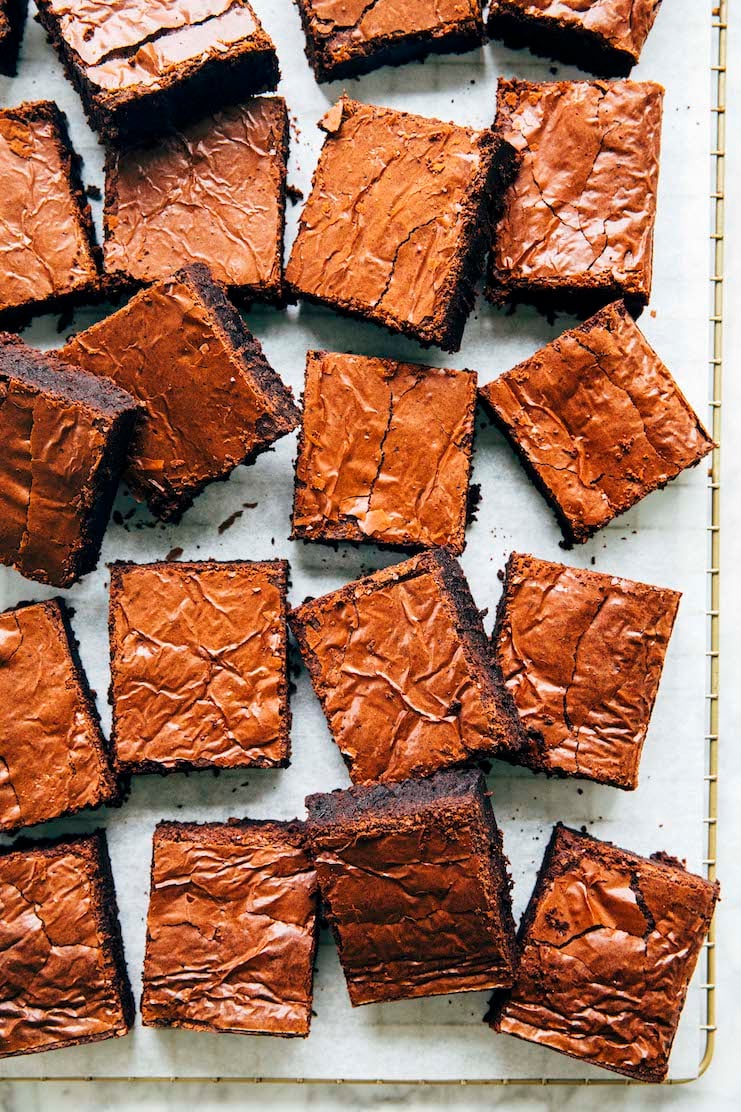
About Stella Parks’ Brownies
Stella Parks’ brownies are thick, incredibly fudgy, and marked by a signature glossy, shiny top that crinkles and flakes when sliced. These brownies are incredibly rich and indulgent thanks to ingredients like brown butter, espresso powder, and both melted chocolate AND Dutch-processed cocoa powder. The recipe is from her James Beard Award-winning cookbook, BraveTart: Iconic American Desserts, and is my favorite brownie recipe beyond my own.
Wait, who is Stella Parks?
Stella Parks is a famed pastry chef and former writer for the famed food website, Serious Eats. Stella began contributing to Serious Eats in 2011 and was the pastry editor at the site from 2016 to 2019. Prior to that, she ran BraveTart, a now-defunct-but-at-the-time-very-popular baking blog. Fun fact: it was her baking blog that inspired me to try making macarons for the first (and only!) time!
Stella is known for her obsessive, detailed baking recipes where she doesn’t shy away from the complicated science of common baking techniques. If you’re looking for a good intro to her extensive body of work, I recommend checking out these articles by Stella:
- “Cookie Science: How Do Eggs Affect My Cookies?”
- “How to Scale a Recipe for Cake to Fit Any Pan”
- “Real Talk: DIY Vanilla Extract Is a Waste of Time and Money”
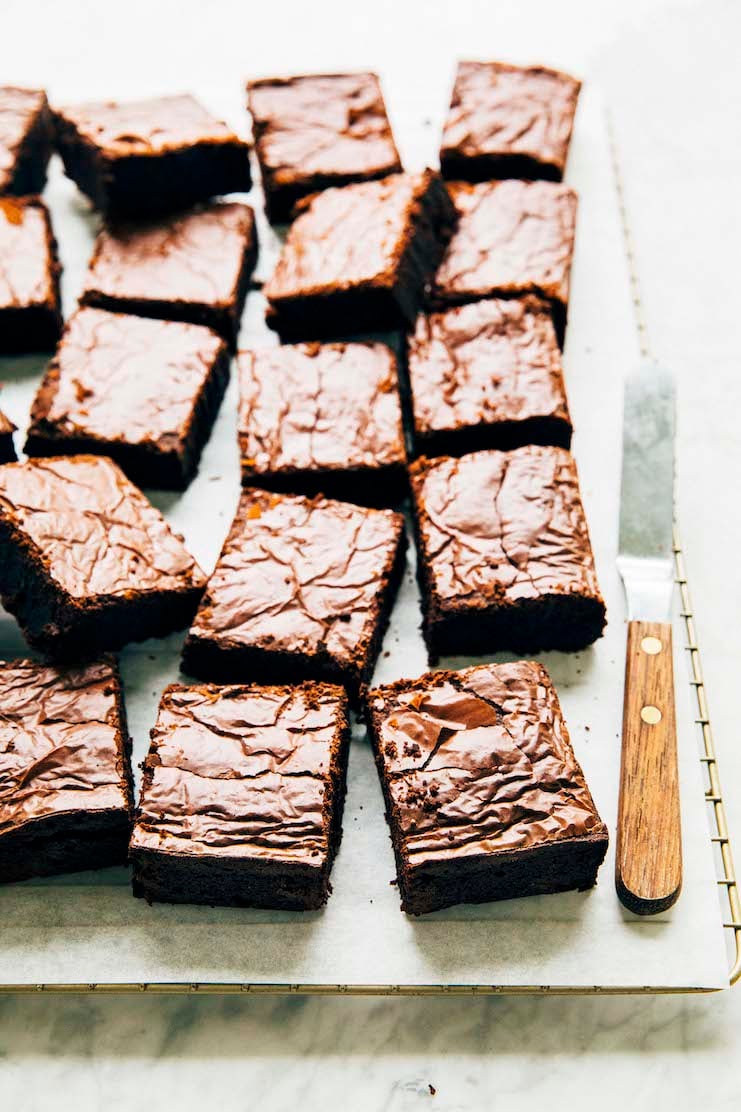
Why You Should Make The Recipe
Here are all the reasons to try Stella Parks’ brownies:
Stella Parks’ brownie recipe uses interesting techniques to make extra flavorful, thick, and shiny brownies.
Let me warn you now—this is not a quick, “weeknight baking” recipe (if you’re looking for one of those, I suggest trying My Best Fudgy Brownies Recipe instead). There are a lot of time consuming techniques in Stella’s recipe: browning the butter, whipping the eggs and sugar into a fluffy meringue-like texture, etc.
Usually, I am suspicious of baking recipes that try too hard. Often times, these extra techniques don’t lead to a more flavorful baked good. But I’m happy to report that I was proven wrong by Stella’s recipe. The brown butter helps temper the intense chocolatey-ness of the brownies, giving them subtle butterscotch and caramel flavors. The whipping technique leads to super fudgy-yet-light brownies with a picture-perfect glossy top.
Stella Parks’ brownies store well.
Because these brownies are so fudgy, rich, and dense, they store well. I found that they were still fresh, moist, and flavorful even 3 days after making them. In fact, I liked them best the day after they were baked. I found that the brownies developed in flavor overnight. The brown butter flavor became even more pronounced! Pretty cool.
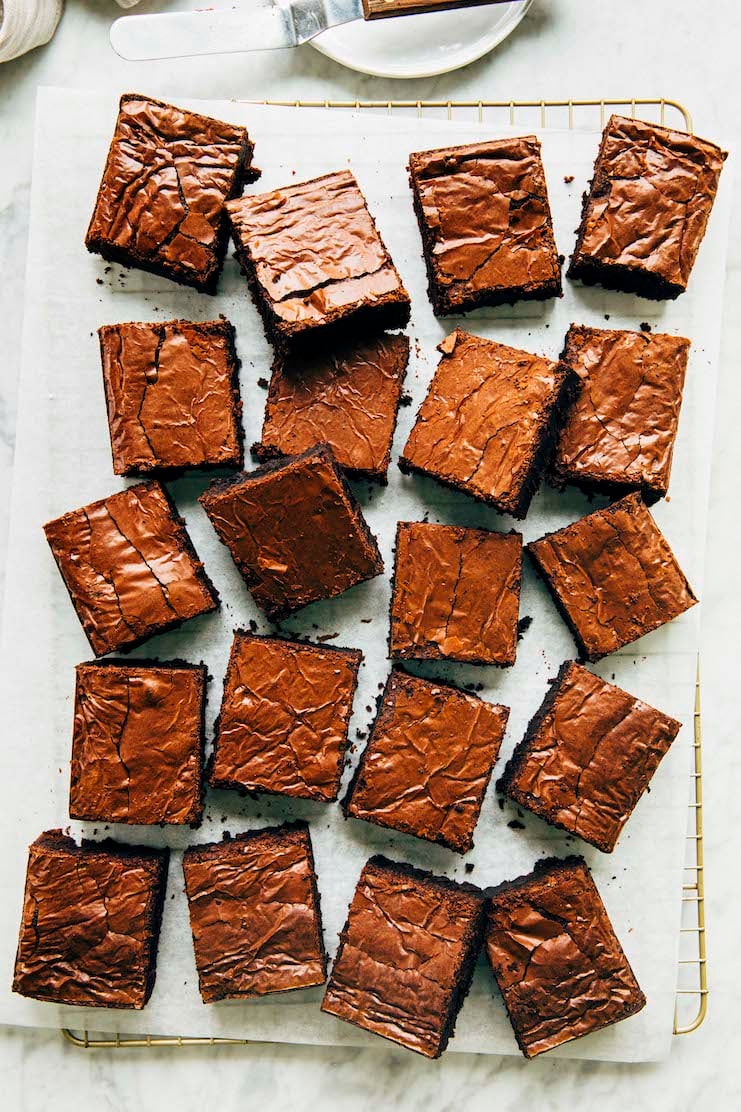
Ingredients and Substitutions
Now that I’ve convinced you to make Stella Parks’ brownies, here’s everything you need for the recipe:
Shopping List for Stella Parks’ Brownies
Be sure to scroll down to the recipe card for the exact ingredient quantities—hit the “Jump to The Recipe” button on the page for a quick shortcut!
- all-purpose flour
- Dutch-processed cocoa powder
- instant espresso powder
- kosher salt
- unsalted butter
- dark chocolate (between 60% to 70% cacao), from whole fèves or a high-quality chocolate bar
- granulated sugar
- light brown sugar
- large eggs
- pure vanilla extract
And let’s talk about some of the recipe’s key ingredients and any potential substitutions:
Dutch-Processed Cocoa Powder
You need 1 ⅓ cups Dutch-processed cocoa powder to make Stella Parks’ brownies.
Natural Unsweetened Cocoa Powder versus Dutch-Processed Cocoa Powder
Cocoa powder, when used in baking recipes, often comes in two varieties: natural unsweetened, and Dutch-processed.
Natural unsweetened cocoa powder is more typical and is cocoa powder in its purest form. It is slightly reddish brown in color and results in deeply flavored chocolate goods. Because it is slightly acidic, it is often paired with baking soda in baking recipes to help create a chemical reaction that will cause the baked good to rise in the oven.
Dutch-processed cocoa powder is natural unsweetened cocoa powder that’s been treated with alkaline to neutralize its acidity, giving it a darker color and milder flavor. It is the cocoa powder that is used for making midnight-black baked goods like Oreos.
I only have natural unsweetened cocoa powder. Can I use that instead?
Yes! You can substitute natural unsweetened cocoa powder for the Dutch-processed cocoa powder in this recipe, no problem. Just a head’s up—your brownies will look and taste just ever-so-slightly different than mine. They will have a more reddish-brown color instead of a blackish-brown one. They’ll also taste a little bit sharper from the acidity of the cocoa powder.
Instant Espresso Powder
You need 1 teaspoon instant espresso to make Stella Parks’ brownies.
What’s espresso powder and where can I find it?
Espresso powder is made from espresso grounds that have been roasted, ground, and brewed. The water is then removed from the espresso either by flash-heat drying or freeze-drying, leaving behind dehydrated crystals.
Historically, espresso powder was primarily used in baking as an ingredient. Bakers frequently use espresso powder in chocolate desserts. Why? The espresso powder intensifies the cocoa flavors in the chocolate without making it taste too much like coffee. You can read more about it in this Kitchn article.
For a long time, espresso powder was only available for purchase online on Amazon or in specialty stores like King Arthur Baking Company. However, these days, folks use espresso powder to make drinks! You can now buy espresso powder in most major grocery stores and Target. In the US, the most readily available instant espresso brand is Medaglia D’Oro.
I don’t want to buy espresso powder. Do I really need to use it to make Stella Parks’ brownies?
I personally think that Stella’s use of espresso powder makes these brownies unique and gives them their super intense, chocolatey flavor. The recipe won’t be the same without them! However, if you can’t find any, then you can simply omit it from the recipe. Your brownies will still be plenty tasty—they’ll just lack the deep, chocolatey nuance that the espresso powder adds.
Kosher Salt
You need 1 ¾ teaspoons kosher salt to make Stella Parks’ brownies.
Why You Should Use Kosher Salt When Baking
I like to use kosher salt (as opposed to table salt) when baking. Its larger crystals make it difficult to confuse with granulated sugar. However, not all kosher salts are created equal. Some kosher salts have smaller granules than others, which will result in saltier tasting baked goods.
For consistency, I recommend sticking to one brand, and one brand only: Diamond Crystal kosher salt. It’s the only brand of salt I use when I develop recipes for Hummingbird High. Why? Diamond Crystal kosher salt is one of the few 100% pure salts in the grocery store. Other brands have additives that can add unexpected flavors to your desserts.
I can’t find Diamond Crystal kosher salt. Is Morton’s Coarse kosher salt okay?
Yes, with reservations. Morton’s Coarse kosher salt granules are much smaller, denser, and crunchier than Diamond Crystal. According to this Food52 article, the two are different shapes and sizes because of how they’re made. Morton’s is made by flattening salt granules into large thin flakes by pressing them through high-pressure rollers, whereas Diamond Crystal is formed by a patented method in which “upside-down pyramids [are] stacked one over the next to form a crystal.” You can even see a visualization of the different sizes in this Cook’s Illustrated article.
Okay, but what does that mean, exactly? 1 teaspoon of Morton’s will taste saltier than 1 teaspoon of Diamond Crystal. Wild, right? So if you follow my recipes exactly as they are written but use Morton’s instead of Diamond Crystal, the results will come out saltier. In fact, sometimes they will come out TOO salty. So if you’re using Morton’s instead of Diamond Crystal, reduce the salt in the recipe by half.
Want to learn more about Diamond Crystal versus Morton’s Coarse kosher salt? Definitely check out the Food52 and Cook’s Illustrated articles I linked to above, as well as this Taste article.
I can’t find Diamond Crystal OR Morton’s Coarse kosher salt. Can I just use table salt?
Yes, with reservations. If you use table salt, you’ll need to reduce the recipe’s salt quantity by half.
If you read my little essay about Diamond Crystal and Morton’s, you learned that Diamond Crystal kosher salt granules are larger than Morton’s kosher salt granules. The same principle applies to table salt versus kosher salt. Table salt granules are much smaller than kosher salt granules. As a result, 1 teaspoon of table salt tastes much saltier than 1 teaspoon of kosher salt… simply because it can hold more granules! Wild, right?
So if you follow my recipes exactly as they are written but use table salt instead of kosher salt, the results will come out saltier. If you’re using table salt instead of kosher salt, I recommend reducing the salt in the recipe by half.
Dark Chocolate
You need 6 ounces (170 grams) dark chocolate to make Stella Parks’ brownies.
Bittersweet versus Semisweet versus Dark Chocolate
Whenever I share a recipe that uses dark chocolate, many of you ask if you can use bittersweet or semisweet chocolate. Many manufacturers make chocolate bars that are specifically for baking; these are often labeled “bittersweet”, “semisweet”, or “unsweetened”. You’ll notice that “bittersweet” and “semisweet” typically don’t include cocoa percentages. That’s because there’s no official benchmark for each designation. Specifically: it’s up to the manufacturers to determine how much cocoa to use, and cacao percentages for each type will vary greatly between brands.
That’s why in my cookbook, I advise folks to ignore these bars and instead stick with the ones that list their cocoa percentages. That’s truly the only way to know what you’re getting! In a pinch, however, you can use either bittersweet or semisweet chocolate for these fudgy brownies without too much consequence.
Do I really need to chop chocolate for this brownie recipe? Can I just melt chocolate chips instead?
Honestly, yes, you can get away with melting chocolate chips in this recipe. However, I don’t recommend it.
Why?
Most grocery store brands—even the ones that offer products specifically made for baking—contain all sorts of additives like paraffin wax and palm oil. These ingredients compromise the flavor and texture of your results. I’ve stopped using chocolate chips in 90 percent of my recipes, and my baked goods have tasted so much better as a result.
That being said, there are some brands that sell high-quality chocolate chips perfect for this recipe. Chocolate chips made by Guittard, Nestle Artisan Collection, and Valrhona use minimal stabilizers and preservatives. Those are the only chocolate chips I recommend for this recipe.
Wait, you’ve scared me off chocolate chips. But I *HATE* chopping up chocolate bars. Is there a halfway point between chocolate bars and chips?
Absolutely! If you want the convenience of chocolate chips but the quality of chocolate bars, I recommend buying chocolate discs or fèves instead.
Discs and fèves are used by fancy chocolatiers to make their own bars and bon bons. They typically don’t use the same preservatives and stabilizers as chocolate chips.
Wait, what are chocolate fèves?
Chocolate fèves are a fancy pastry school term for a flat, bean-shaped disc of chocolate. The most prominent maker of chocolate fèves is one of my favorite chocolate makers, Valrhona Chocolate. For these brownies, I used Valrhona’s Caraibe 66% chococlate fèves You can buy them online and/or at select Whole Foods Market locations.
I don’t have chocolate. Can I substitute the chocolate in the recipe with cocoa powder?
Many of you also asked if you could substitute the chocolate in the recipe with cocoa powder. Unfortunately, the answer is no. That would change the recipe completely and it would no longer make Stella Parks’ brownies.
If you only have cocoa powder on hand, I highly suggest checking out the Better-Than-Box-Mix Cocoa Brownie recipe in my cookbook. Although it’s currently not on my blog, my friend Jeanine recently published the recipe on her site, Love and Lemons.
Brown Sugar
You need ¼ cup tightly packed light brown sugar to make Stella Parks’ brownies.
I don’t have any brown sugar. Can I use all granulated white sugar instead to make these brownies?
Technically yes, but I don’t recommend it. The brown sugar is what gives the brownies their unique, fudgy texture, as well as subtle caramel and butterscotch flavors without being overly sweet. If you use all white sugar, the texture will be a little different and they’ll taste a LOT sweeter. And trust me—these brownies are plenty sweet already!
Can I use dark brown sugar instead of light brown sugar?
Brown sugar is granulated white sugar with a touch of molasses to give it its signature color and flavor. Because brown sugar contains molasses, it adds more moisture baked goods than granulated sugar otherwise would.
Brown sugar is available in two varieties: light or dark. If dark brown sugar is all you have, you can use it in this recipe without altering its flavor too much. However, you may need to add 1 to 2 minutes extra to the recipe’s Bake Time.
Can I use coconut sugar instead of brown sugar?
Yes, with reservations. Coconut sugar is more similar to granulated sugar when it comes to moisture levels. If you use coconut sugar in this recipe, your brownies will have a slightly drier, less fudgy texture than mine. I recommend checking for doneness a few minutes earlier than what’s stated in the recipe below.
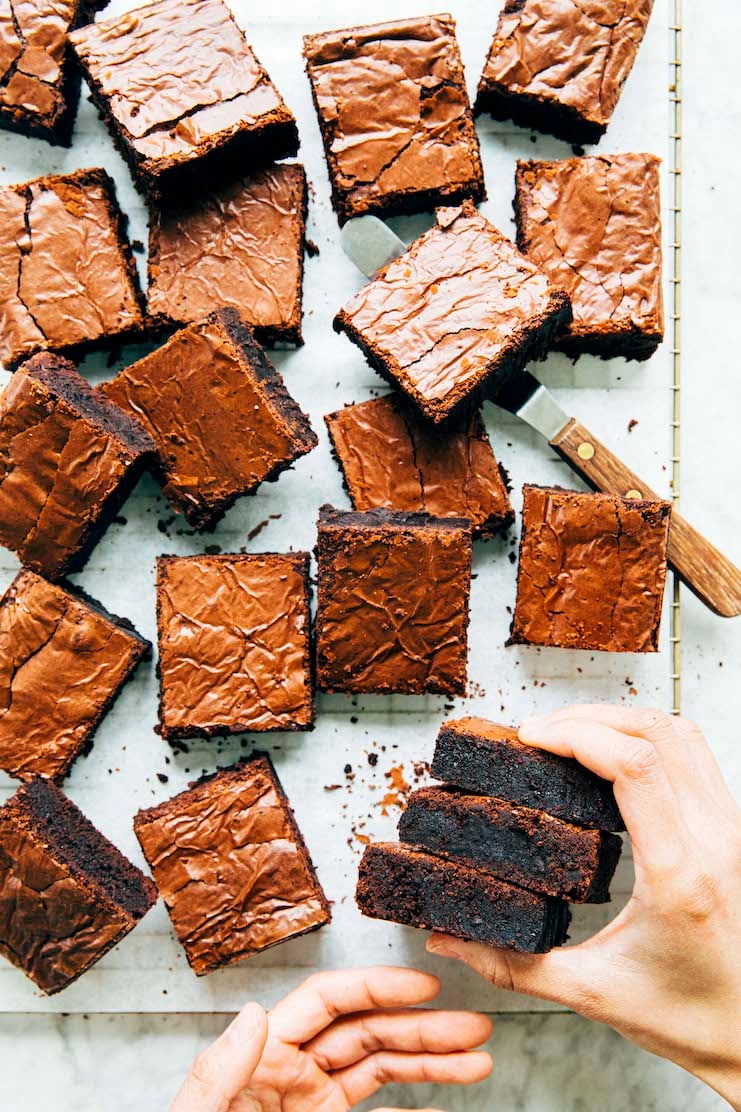
How To Make The Recipe
Here are the basic steps to make Stella Parks’ brownies from scratch:
- Prep the ingredients for the fudgy brownies. (Prep Time: 5 to 10 minutes)
It usually takes 5 minutes to prep—that is, measure out all the ingredients needed for the recipe itself—for most of the recipes on this blog. However, if you’re using chocolate bars to make these brownies, you need to chop up the chocolate. Doing so usually takes around 5 minutes.
To save yourself time, buy thin chocolate bars that are easier to slice. You can also use a food processor to chop the chocolate. But my personal recommendation is to use chocolate discs or fèves for the recipe! You won’t need to chop them before melting. - Brown the butter and melt the chocolate. (Work Time: 5 to 15 minutes)
Depending on how high the heat is and how cold your butter was to begin with, browning butter can take anywhere from 5 to 15 minutes. To speed up the process, you can slice the butter into smaller pieces to encourage it to melt faster.
Once the butter is browned to the color of your choice (learn more in the Baking Tips section below), stir in the chopped chocolate to melt it completely and combine it with the brown butter. I recommend chopping the chocolate into fairly small ½- and 1-inch pieces to get it to incorporate easily. - Whisk the sugars, eggs, vanilla, then add the chocolate mixture and dry ingredients. (Work Time: 15 minutes)
In the bowl of a stand mixer fitted with the whisk attachment, combine the sugars, eggs, and vanilla. Whisk on medium-high speed for 8 minutes; you’re basically making a fluffy meringue with these ingredients! Once cloudlike, add the warm chocolate-butter mixture and the dry ingredients. - Assemble the brownies. (Work Time: <5 minutes)
Pour the brownie batter into a 9 x 13-inch pan lined with parchment paper. Use an offset spatula to spread the batter evenly across the pan and smooth its top. - Bake the brownies. (Bake Time: 35 minutes)
This recipe bakes for between 35 and 40 minutes. When baking brownies, it’s always better to pull them out of the oven early. Leaving them in too long means that they’ll turn out tough! check out the recipe and FAQ below for more tips.
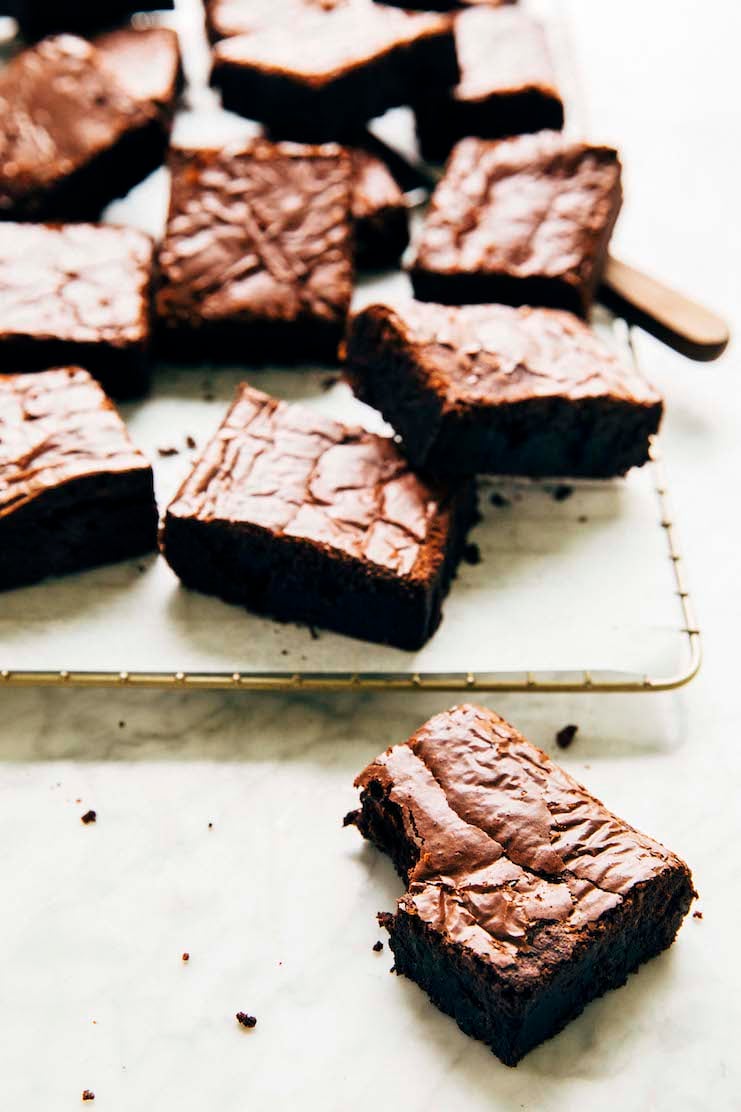
Recipe Troubleshooting and FAQ
FAQ: All About The Baking Equipment You Need To Make The Recipe
Tools You Need To Make Stella Parks’ Brownies
To make this recipe, you need the following baking equipment:
- a light colored sauce pan
- a stand mixer with a whisk and paddle attachment
- a metal 9 x 13-inch baking pan
You need a light-colored sauce pan to brown butter for the recipe, a stand mixer to make the batter, and a metal baking pan to bake the brownies in.
Why do I need a light colored sauce pan to brown butter?
Brown butter is made by cooking butter until the water in it evaporates and you’re left with an amber-colored liquid with a rich flavor and a wonderfully nutty aroma. However, as the butter melts, it foams an incredible amount, making it difficult to see the butter’s color. A light-colored sauce pan will help mitigate this issue.
If you don’t have a light colored pan, you can use a spoon to scoop a small amount of the butter onto a white plate. Doing so will help you see its color more clearly.
I don’t have a stand mixer. Can I use a handheld electric mixer instead?
Yes! For all recipes on Hummingbird High, unless I explicitly state otherwise, you can always use a handheld electric mixer instead of a stand mixer. Just note that handheld mixers are less powerful than stand mixer. You may need to add 1 to 2 minutes of extra mixing time to whatever is stated in the recipe.
Why is it better to use a glass or metal pan when baking brownies?
Alright, here we go—when you google the answer to this question, the first few search results will tell you that it is better to use a glass pan when baking brownies. THEY ARE 100% INCORRECT. It is my *FIRM* opinion that it is always, ALWAYS better to use a metal pan when baking brownies.
Why? Glass pans are slow to heat up; however, when hot, they retain heat for much longer. This quality often results in uneven baking. By the time the interior of whatever you’re baking is done, the exterior of it is often overcooked, dry, and overly dark.
What does that mean for these fudgy brownies? If you’re baking the brownies in a glass pan, they’ll continue to bake LONG after being pulled out of the oven because the pan continues to retain so much heat. That usually means dense, dry, and overcooked brownies that are not fudgy at all.
Metal, on the other hand, conducts heat. Because metal heats up faster than glass, it leads to brownies with a better rise (but without being cake) with crispier edges. And because metal pans lose heat quickly after being pulled out of the oven, your brownies will too. That means the brownies will cool faster, and they won’t be overdone. Instead, they will instead be perfectly fudgy and set. So please use a metal pan for this recipe!
Finally, if you want to be a perfectionist, choose a light colored metal pan over a dark metal pan. Dark pans absorb more heat, which, like glass, can cause the exterior of the brownies to bake too quickly. I always use pans from Williams-Sonoma’s Goldtouch Pro Nonstick line for my baking.
FAQ: Customizing The Recipe
Can I half the recipe and bake it in an 8- or 9-inch square pan instead?
Yes! You can easily half the amount of ingredients in the recipe and bake it in an 8- or 9-inch square pan instead. Bake Time will likely be closer to the 35-minute range (as opposed to 40 minutes).
FAQ: Troubleshooting Common Mistakes and Cooking Errors
Help! My brownies don’t have the shiny paper crinkle top like yours do. What did I do wrong?
It’s likely that you either:
a) used too much flour
b) used too little sugar
c) baked the brownies for too long and/or used the wrong type of pan to make them.
First, let’s talk about measuring ingredients. A lot of people don’t have the right technique when using measuring cups. It’s easy to use too much flour when using volume measures. Don’t use the measuring cup to scoop the flour in the bag and pack it down into the cup. Instead, set the measuring cup on the counter and then spoon the dry ingredients into it. Once it’s formed a small mound, don’t pack it down. Use a butter knife or bench scraper to level it off.
While this technique works best for ingredients like flour, you’ll need to do the exact opposite for measuring brown sugar. Spoon the brown sugar into the measuring cup. Once it’s formed a small mound, pack it down, then add more brown sugar until it is level with the top of the measuring cup.
Finally, if you used the techniques above OR used weight measures (which I always recommend, since you won’t need to fuss with the techniques I just outlined) and are STILL experiencing issues, it’s likely that the brownies were overbaked. Check out the FAQ above on why you should always use a metal pan when baking brownies, as well as the baker’s notes below on how to test brownies for doneness.
Help! My brownies came out tough. What did I do wrong?
It’s likely that you either a) overmixed the batter or b) baked the brownies for too long and/or used the wrong type of pan to make them.
When mixing the dry ingredients into the rest of the batter, simply mix until the ingredients disappear into the batter, then 1 minute more after that! If you mix beyond that, your brownies will come out dense and tough. I will legit cry for you.
If you’re convinced you didn’t overmix the batter, it’s likely that you overbaked them. First, make sure to use a metal pan when baking brownies. I’ve already explained why it’s important to do so in the FAQ above. But the TL/DR is that gass pans tend to overbake brownies!
Finally, when testing for doneness, stick a skewer in the dead center of the brownies. Pull it out—it should still have a few crumbs attached. If it’s wet with batter, the brownies still need more time. If the skewer is completely dry, uh-oh! You’ve overbaked the brownies.
FAQ: How To Store The Brownies
How To Store Stella Parks’ Brownies
The brownies can be stored in an airtight container or zip-top bag at room temperature for up to 3 days.
Can you freeze this brownie recipe?
Yes! You can freeze the baked brownies.
To freeze the brownies, individually wrap any leftover bars in two layers of plastic wrap, then a layer of aluminum foil. The aluminum foil will prevent the bars from absorbing any other flavors or odors in the freezer. Freeze for up to 3 months.
When ready to serve, transfer to the refrigerator to thaw overnight. You can eat the brownies straight from the fridge, or rewarmed in the microwave.
Best Brownie Recipe Tips
Best Ingredient Tip
- The brownie batter recipe states that you need 6 ounces (170 grams) of chopped dark chocolate to make the brownie batter. If you don’t have a digital kitchen scale, that’s equivalent to 1 cup of chopped chocolate. Each piece of chocolate should be roughly the same size and shape of a regular-sized chocolate chip.
Best Technique Tips
- When cooking the butter, its color will progress from a bright lemon yellow to a golden tan and finally, a dark amber brown. The longer you cook the butter, the darker and more flavorful it will be. However, there is a fine line between toasted and burnt! There’s no salvaging butter once it’s burnt, so be sure to watch it like a hawk as it browns.
- The recipe instructs you to add the dry ingredients into a thick, sludgy chocolaty batter. When doing so, make sure your stand mixer is on its slowest setting! If you add too much at once, the dry ingredients have a tendency to fly out the bowl and make a huge mess. I recommend adding the dry ingredients 1 to 2 Tablespoons at a time, only adding the next batch when the previous ones are fully incorporated.
Best Baking Tip
- It’s better to pull the brownies out of the oven early than leave them in too long—if you over bake the brownies, they’ll be tough. They might appear underbaked, but I promise that when they’ve cooled, they will be perfect.
More Brownie Recipes
- Almond Flour Brownies (Small Batch)
- Baileys Brownies (Small Batch)
- Brookie Bars (Small Batch)
- Claire Saffitz’s Brownie Recipe
- Flourless Gluten Free Cheesecake Brownies
- Milk Chocolate Brownies
- My Best Fudgy Brownie Recipe
- Slutty Brownies (Small Batch)
- Small Batch Brownies
- Supernatural Brownies
Get the Recipe: Stella Parks’ Brownie Recipe
Ingredients
- 1 cup (4.5 ounces or 128 grams) all-purpose flour
- 1 ⅓ cups (4 ounces or 113 grams) Dutch-processed cocoa powder, sifted if necessary
- 1 teaspoon instant espresso powder
- 1 ¾ teaspoons kosher salt
- 1 ½ cups (3 sticks or 12 ounces or 340 grams) unsalted butter
- 6 ounces (170 grams) dark chocolate (between 60% to 70% cacao), from whole fèves or a high-quality chocolate bar chopped into ½- and 1-inch pieces
- 2 ¼ cups (16 ounces or 454 grams) granulated sugar
- ¼ cup tightly packed (2 ounces or 57 grams) light brown sugar
- 6 large eggs
- 1 Tablespoon pure vanilla extract
Instructions
- Prep your oven and pan. Position a rack in the center of the oven and preheat the oven to 350°F. Lightly spray a 9 x 13-inch cake pan with cooking spray and line with parchment paper, leaving a 2-inch overhang on the pan’s two long sides. Spray the parchment, too.
- Mix the dry ingredients. In a medium bowl, whisk together the flour, cocoa powder, espresso powder, and salt.
- Brown the butter, then add the chocolate. In a light-colored saucepan, melt the butter over medium-low heat, swirling the pan occasionally, until it starts to foam. Use a heatproof rubber spatula to scrape the bottom and sides of the pan occasionally to prevent the milk solids in the butter from burning. Cook for 5 minutes, or until the butter smells nutty and is amber with dark flecks at the bottom of the pan. Remove from the heat and immediately add the chopped chocolate. Stir with a rubber spatula until the chocolate is completely melted and combined. Pour the mixture into a liquid measuring cup. Set it on a wire rack to cool slightly while you prep the other ingredients.
- Whisk the sugars, eggs, vanilla, then add the chocolate mixture. In the bowl of a stand mixer fitted with the whisk attachment, combine the sugars, eggs, and vanilla. Whisk on medium-high speed for 8 minutes, or until thick, fluffy, and doubled in volume. Reduce to low and slowly pour in the warm chocolate mixture, mixing on low speed until just combined.
- Mix in the dry ingredients. Once the chocolate mixture is combined, use a rubber spatula to scrape down the whisk and the bottom and sides of the bowl. Affix the paddle attachment to the mixer and gradually add the dry ingredients, mixing on low speed until just combined.
- Assemble the brownies. Pour the batter into the prepared pan and use an offset spatula to smooth the top.
- Bake the brownies. Bake for 35 to 40 minutes, or until a skewer inserted into the center of the brownies comes out with a few crumbs attached. Cool completely on a wire rack before slicing.
- Serve and store. Run a butter knife or offset spatula along the edges of the pan and use the overhanging parchment as handles to lift the brownies out of the pan and onto a cutting board. Slice into 20 rectangles, each about 2 ¼ inches wide and 2 ½ inches long, and serve. The brownies can be stored in an airtight container or zip-top bag at room temperature for up to 3 days.
Notes
- Adapted from Stella Parks’ BraveTart: Iconic American Desserts
- The brownie batter recipe states that you need 6 ounces (170 grams) of chopped dark chocolate to make the brownie batter. If you don’t have a digital kitchen scale, that’s equivalent to 1 cup of chopped chocolate. Each piece of chocolate should be roughly the same size and shape of a regular-sized chocolate chip.
- When cooking the butter, its color will progress from a bright lemon yellow to a golden tan and finally, a dark amber brown. The longer you cook the butter, the darker and more flavorful it will be. However, there is a fine line between toasted and burnt! There’s no salvaging butter once it’s burnt, so be sure to watch it like a hawk as it browns.
- The recipe instructs you to add the dry ingredients into a thick, sludgy chocolaty batter. When doing so, make sure your stand mixer is on its slowest setting! If you add too much at once, the dry ingredients have a tendency to fly out the bowl and make a huge mess. I recommend adding the dry ingredients 1 to 2 Tablespoons at a time, only adding the next batch when the previous ones are fully incorporated.
- It’s better to pull the brownies out of the oven early than leave them in too long—if you over bake the brownies, they’ll be tough. They might appear underbaked, but I promise that when they’ve cooled, they will be perfect.
What I Really Think of Stella Parks’ Brownies
Of the four brownie recipes I made this month, Stella Parks’ brownie recipe was my favorite (beyond my own). I loved their rich, decadent flavor. I thought they were the perfect thickness, and I could not get over how glossy and shiny their tops were. That being said, many of the folks I gave samples to found her brownies to be TOO decadent. Her brownies are definitely intense! Even despite my major sweet tooth, I found it hard to have more than one brownie at a time. While some people argued that this was a bad thing, I thought it was a favorable quality since their richness kept me from overindulging.
The only “con” I could really think of was that her recipe was pretty time-consuming and fussy when compared to other brownie recipes. Although it doesn’t take quite as much time as Claire Saffitz’s brownie recipe, there were several steps—like browning the butter, and whipping the sugar and eggs—that still took a fair amount of time. It was also the only recipe that used a stand mixer and two different attachments, leading to more clean-up afterwards. This is definitely not the brownie recipe to make if you’re in a rush.
Changes I Made To Stella Parks’ Brownie Recipe
I made this recipe three times before publishing this version of it on Hummingbird High. The first time, I’d followed the directions exactly as they were written in Stella’s cookbook. The next two times, I made some subtle technique changes that I thought would lead to a more successful result. Here’s a summary of everything I changed below:
- Instructed you to line the baking pan with parchment paper as opposed to aluminum foil. In the original recipe, Stella instructs you to line the baking pan with aluminum foil instead of parchment paper. I prefer to line my pans with parchment paper. Parchment paper has better nonstick qualities than aluminum foil, and doesn’t tear as easily when pressed into the corners of the pan.
- Instructed you to use the mixer’s paddle attachment to mix in the dry ingredients. In Stella’s original recipe, she instructs you to fold in the dry ingredients (specifically, the flour and cocoa powder) in by hand with a rubber spatula. However, I found it really difficult to do so. The chocolaty mixture that you’re folding the ingredients into is pretty thick and sludgy—you end up getting quite the arm workout! To make my life easier, I just used my stand mixer to mix everything together.
That being said, I understand why Stella instructs you to mix in the dry ingredients by hand. If you add the dry ingredients to the mixer too quickly, they have a tendency to shoot out of the stand mixer bowl and make a big mess. Be sure to check out the Baker’s Tips for some advice on how to prevent this from happening! - Adjusted the Bake Time significantly. Stella’s original recipe instructs you to bake the brownies for 25 minutes, or until a thermometer inserted into the center of the brownies reads 205°F. At 25 minutes, my thermometer read nowhere NEAR 205°F. At 25 minutes, the internal temperature of the brownies read something like 150°F. It only started to reach the 200°F range at the 35 to 40 minute mark. I’m seriously convinced that the original time of 25 minutes in her book is a typo!
Did you make this recipe?
Please leave a comment and rating for the recipe using the form below!
Your ratings make it easier to find the recipe online, and I’m always looking for ways to improve Hummingbird High.

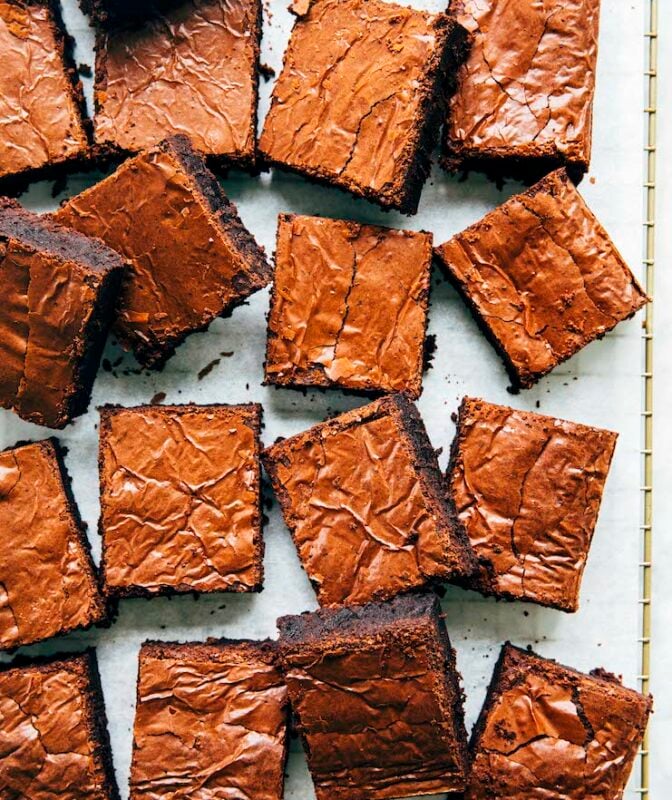
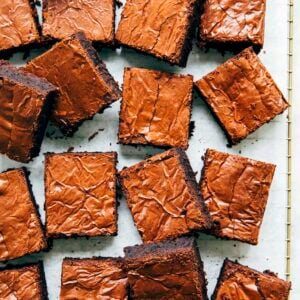
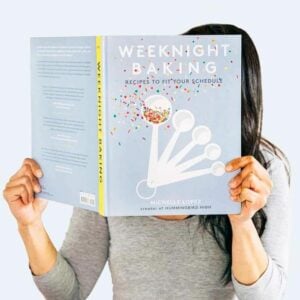

Hi Michelle
Do you agree with Stella Parks Post about DIY Vanilla Extract is a waste of time and money.
Mmm, mixed feelings. It takes a long time to make vanilla extract at home—usually I cure my homemade vanilla for 1 year! So I do think it’s easier to buy/you can get better quality products that way. But it’s also fun to make at home/be able to control the amount and type of vanilla in the extract.